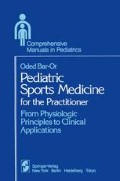Abstract
The O2-carrying capacity of blood and the blood flow to any tissue determine the capability of this tissue to raise its aerobic metabolism. The same principle applies to the body as a whole. Changes in hemoglobin (Hb) concentration, unless accompanied by a variation in blood volume or in an affinity of Hb to O2, closely reflect changes in the O2-carrying capacity of the blood. For practical purposes, therefore, we shall use the reduction of Hb concentration as an index of the severity of anemia and of a decrease in O2-carrying capacity.
Access this chapter
Tax calculation will be finalised at checkout
Purchases are for personal use only
Preview
Unable to display preview. Download preview PDF.
References
Alpert BS, Gilman PA, Strong WB, et al: Hemodynamic and ECG responses to exercise in children with sickle cell anemia. Am J Dis Child 135:362–366, 1981.
Attlee WHW: Haemoglobinuria following exertion. Lancet 1:1400, 1937.
Austin PL, Stegink LD, Gisalfi CV: The effect of exercise on red blood cell 2,3-diphosphoglycerate in children. J Pediatr 83:41–45, 1973.
Chaplin H Jr, Perkoff GT, Frisbie JH, et al: March hemoglobinuria associated with asymptomatic congenital heart disease. JAMA 208:1700–1702, 1969.
Cropp GJA: Cardiovascular function in children with severe anemia. Circulation 39:775–784, 1969.
Davidson RJL: Exertional hemoglobinuria: a report on three cases with studies on the haemolytic mechanism. J Clin Pathol 17:536–540, 1964.
Davidson RJL: March or exertional hemoglobinuria. Semin Haematol 6:150–161, 1969.
Davies CTM, Chukweumeka AC, Van Haaren JPM: Iron deficiency anemia—its effect on maximum aerobic power and responses to exercise in African males aged 17–40 years. Clin Sci 44:555–562, 1973.
Dietrich S: Hemophilia: a total approach to treatment and rehabilitation. Los Angeles Orthopedic Hospital, 1968.
Ehlers KH, Levin R, Klein AA, et al: The cardiac manifestations in thalassemia major: natural history, non-invasive cardiac diagnosis studies and results of cardiac catheterization. In: Engle MA (ed.) Pediatric Cardiovascular Disease. Davis, Philadelphia, 1980, pp. 171–186.
Ehn L, Carlmark B, Hoglund S: Iron in young sportsmen. In: Eriksson B, Furberg B (eds.) Swimming Medicine IV. University Park Press, Baltimore, 1978, pp. 85–88.
Flatmark T: Studies on the hemolytic mechanism in March hemoglobinuria. Acta Med Scand 173:307–313, 1963.
Flood NL, Alpert BS, Strong WB, et al: Exercise in children with sickle cell trait (abstract). Med Sci Sports Exercise 14:123, 1982.
Gandini S, Panicucci F, Bastianini C: L’attivitá sportiva como fattore preventivo, terapeutico e riabilitativo delle artropatie negli emofilici. Med Sport 32:43–44, 1979.
Gandra YR, Bradfield RB: Energy expenditure and oxygen handling efficiency of anemic schoolchildren. Am J Clin Nutr 24:1451–1456, 1971.
Gilligan DR, Altschule MD, Katersky EM: Physiological intravascular hemolysis of exercise. Hemoglobinemia and hemoglobinuria following crosscountry runs. J Clin Invest 22:859–869, 1943.
Hamilton W, Rosenthal A, Berwich D, Nadas AS: Angina pectoris in a child with sickle-cell anemia. Pediatrics 61:911–914, 1978.
Ireland T: The role of exercise in the management of hemophilia (personal communication), 1978.
Levin AR, Klein AA, Ehlers KH, et al: Hemodynamic and left ventricular volume and function characteristics in thalassemia major. Pediatr Res 12:386, 1978.
Martin H, Kilian P: Marschhämoglobinurie. Folia Haemat 4:92–117, 1959.
Ohno Y, Sato M, Kurokawa I, et al: Exertional hemoglobinuria. Tohuko J Exp Med 117:187–191, 1975.
Pate RR: Sports anemia: a review of the current research literature. Physician Sportsmed 11:115–131, 1983.
Parsons EC, Wright FH: Circulatory function in the anemias of children. I. Effect of anemia on exercise tolerance and vital capacity. Am J Dis Child 57:15–28, 1939.
Russ K, Bartlett GS: Risk-taking behavior in hemophiliac and non-hemophiliac adolescent boys. Pediatr Res 12:366, 1978.
Sproule BJ, Halden ER, Miller WF: A study of cardiopulmonary alterations in patients with sickle cell disease and its variants. J Clin Invest 37:486–495, 1958.
Sproule BJ, Mitchell JH, Miller WF: Cardiopulmonary physiological responses to heavy exercise in patients with anemia. J Clin Invest 39:378–388, 1960.
Ulmer HE, Griener H, Schuler HW, Scharer K: Cardiovascular impairment and physical working capacity in children with chronic renal failure. Acta Paediatr Scand 67:43–48, 1978.
Vellar OD: Studies on sweat losses of nutrients. I: Iron content of whole body sweat constituents, serum iron levels, hematological indices, body surface area, and sweat rate. Scand J Clin Lab Invest 21:157–167, 1968.
Viteri FE, Torun B: Anaemia and physical working capacity. Clin Haematol 3:609–626, 1974.
Weigel N, Carlson BR: Physical activity and the hemophiliac: yes or no? Am Correct Ther J 29:197–205, 1975.
Yoshimura H: Anemia during physical training (sports anemia). Nutr Rev 28:251–253, 1970.
Author information
Authors and Affiliations
Rights and permissions
Copyright information
© 1983 Springer-Verlag New York Inc.
About this chapter
Cite this chapter
Bar-Or, O. (1983). Hematologic Diseases. In: Pediatric Sports Medicine for the Practitioner. Comprehensive Manuals in Pediatrics. Springer, New York, NY. https://doi.org/10.1007/978-1-4612-5593-2_8
Download citation
DOI: https://doi.org/10.1007/978-1-4612-5593-2_8
Publisher Name: Springer, New York, NY
Print ISBN: 978-1-4612-5595-6
Online ISBN: 978-1-4612-5593-2
eBook Packages: Springer Book Archive

